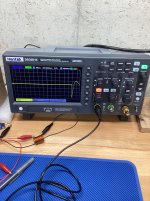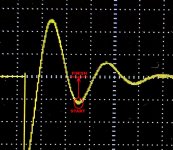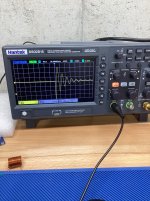I don't have the second channel on. I am reading this with only the channel 1 probe hooked up. I now have a relatively stable wave form at 2 volts/division and 1us/division. But the waveform is to the extreme right of the screen, and the horizontal position knob will not let me move it to the left.
I don't understand what the channel 2 probe would be reading. I'll go back to Mark's abstract and re-read what it says about it. But I thought he said you could get a reading with just one channel.
Thanks,
John
I don't understand what the channel 2 probe would be reading. I'll go back to Mark's abstract and re-read what it says about it. But I thought he said you could get a reading with just one channel.
Thanks,
John
Attachments
Ok, I see the way it should be set up with two probes under the heading "Triggering The Oscilloscope". I think the second probe provided with the Hantek scope is a high voltage probe. Let me think about I can make this work.
Thanks,
John
Thanks,
John
Okay, I set up everything again, after reading every write up from @Mark Johnson and now it really works without issues - lession learned: RTFM! And with this correct setup I get 33,1 ohms for the Toroidy TTSA0020 with shorted 230 VAC primary and 2x15 VAC secondaries, one of them shorted (caps 150 nF/10 nF).
Setup is: trigger set to - 2 volts (the minimum possible value) and falling edge, T 1 us.
Could someone please tell if it is correct, based on the graphs? Many thanks in advance.


Setup is: trigger set to - 2 volts (the minimum possible value) and falling edge, T 1 us.
Could someone please tell if it is correct, based on the graphs? Many thanks in advance.
Istvan, did you use 1 probe/channel or 2 probes/channels on your scope to get these results? I am going to order a second probe because I now understand how to hook it up. Not so sure about how to use one probe to both trigger and display the waveform.Okay, I set up everything again, after reading every write up from @Mark Johnson and now it really works without issues - lession learned: RTFM! And with this correct setup I get 33,1 ohms for the Toroidy TTSA0020 with shorted 230 VAC primary and 2x15 VAC secondaries, one of them shorted (caps 150 nF/10 nF).
Setup is: trigger set to - 2 volts (the minimum possible value) and falling edge, T 1 us.
Could someone please tell if it is correct, based on the graphs? Many thanks in advance.
View attachment 1463345
View attachment 1463346
John
John, I have only 1 probe, so followed Mark's recommendation for this case.
With one probe, you should make proper settings and I think you could use my settings. Probe to the Quasimodo scope pin, trigger of the scope at -4 volts (my limit is -2 volts but it works too) and falling edge, time 1 us, channel voltage range 2 volts, sensor and scope sensitivity must be the same.
Remove the trim pot, turn the Quasi on and you should get a ringing sinusoid thingie. Play with the voltage until the graph is similar to mine, but let the time at 1-2 us. Put in the trim pot without changing the settings (you can see, my settings are identical before and after) and turn it until you get just one bump. I set my trim pot to about 15 ohms before putting it in.
With one probe, you should make proper settings and I think you could use my settings. Probe to the Quasimodo scope pin, trigger of the scope at -4 volts (my limit is -2 volts but it works too) and falling edge, time 1 us, channel voltage range 2 volts, sensor and scope sensitivity must be the same.
Remove the trim pot, turn the Quasi on and you should get a ringing sinusoid thingie. Play with the voltage until the graph is similar to mine, but let the time at 1-2 us. Put in the trim pot without changing the settings (you can see, my settings are identical before and after) and turn it until you get just one bump. I set my trim pot to about 15 ohms before putting it in.
This test set-up uses two channels and two probes for the best capture. One probe sends the signal to channel 1, the second probe sends the trigger signal to channel 1 (you must set the trigger to pickup on channel two since the lead will be connected to channel two). I believe there is a method for only one probe, but I have never tried it.
I will give it a try.John, I have only 1 probe, so followed Mark's recommendation for this case.
With one probe, you should make proper settings and I think you could use my settings. Probe to the Quasimodo scope pin, trigger of the scope at -4 volts (my limit is -2 volts but it works too) and falling edge, time 1 us, channel voltage range 2 volts, sensor and scope sensitivity must be the same.
Remove the trim pot, turn the Quasi on and you should get a ringing sinusoid thingie. Play with the voltage until the graph is similar to mine, but let the time at 1-2 us. Put in the trim pot without changing the settings (you can see, my settings are identical before and after) and turn it until you get just one bump. I set my trim pot to about 15 ohms before putting it in.
Thanks,
John
RickRay,
I know it can work with one probe because I had it working....but I lost the plot by not paying attention to the settings. But you are right, the best way to do it per Mark's abstract is to use 2 probes. I can buy a second Hantek probe for less than $10 on Amazon. I'm interested enough in this topic to get the second probe and experiment with it to get the best capture possible.
Thank you for the help,
John
I know it can work with one probe because I had it working....but I lost the plot by not paying attention to the settings. But you are right, the best way to do it per Mark's abstract is to use 2 probes. I can buy a second Hantek probe for less than $10 on Amazon. I'm interested enough in this topic to get the second probe and experiment with it to get the best capture possible.
Thank you for the help,
John
I’ve never used 2 probes with Quasimodo… had to re-read the documentation when it was mentioned a few posts ago to see what was specifically said.
One works fine, I’d suggest not buying a 2nd probe as that’s going to add more variables for you to manage.
(Actually, yes, get the probe, as there are times you really need 2… but this isn't one of them.)
🙂
One works fine, I’d suggest not buying a 2nd probe as that’s going to add more variables for you to manage.
(Actually, yes, get the probe, as there are times you really need 2… but this isn't one of them.)
🙂
That's interesting Jim. I'll try it with one probe before I do anything.
I appreciate the perspective,
John
I appreciate the perspective,
John
Ok, after twirling the controls on my Hantek DSO2D15 I get what I think are reasonable wave forms. I have a pair of Antek-0218 transformers that I intend to use in a balanced Zen Mod Preamp yet to be built. These are 25 VA transformers with dual 18 V secondaries. I am getting a Rs reading of about 24 ohms on one of the transformers and 88 ohms on the second transformer. This seems to me to be too big of a difference.
I am using one probe and triggering on the falling edge. Does it make sense that the two transformers could measure that differently? The pictures below show one transformer with R5 trimmer out of the circuit and then in circuit. Both secondaries on both transformers measure close to each other, but the difference between the two transformers is making me wonder.....
John
I am using one probe and triggering on the falling edge. Does it make sense that the two transformers could measure that differently? The pictures below show one transformer with R5 trimmer out of the circuit and then in circuit. Both secondaries on both transformers measure close to each other, but the difference between the two transformers is making me wonder.....
John
Attachments
Jim, I've done this multiple times, one transformer right after the other. As far as I can discern everything is the same. It's making me wonder if one of the transformers is defective.
Interesting for sure, that’s a possibility…
Measure the ohms of each winding, comparing the two transformers, are there any differences?
Measure the ohms of each winding, comparing the two transformers, are there any differences?
Jim, the transformers are fine. The problem is me. Both of the Antek secondaries are green and blue. On one of the transformers I mixed the green wire of one secondary winding with the blue wire of the other secondary. Those wires are discontinuous. The second I ohmed out the windings at your suggestion I realized what I had done. Both windings of both transformers require an Rs of approximately 38 ohms.
On the Toroidy transformers I'm using for the Wolverine the secondaries are Red-Red and Violet-Violet....so it's close to impossible to cross the wires.
Thanks for hanging in there with me. I really appreciate it.
John
On the Toroidy transformers I'm using for the Wolverine the secondaries are Red-Red and Violet-Violet....so it's close to impossible to cross the wires.
Thanks for hanging in there with me. I really appreciate it.
John
- Home
- Amplifiers
- Power Supplies
- Simple, no-math transformer snubber using Quasimodo test-jig



